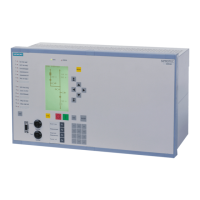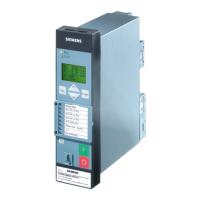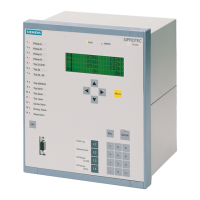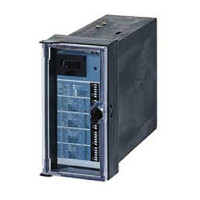1218. It is usually used for purposes of current grading intended for large impedances that are prevalent in
transformers or generators. It is specified in such manner that it picks up faults up to this impedance.
Example of the high-set current element 50-2 PICKUP: Transformer used for busbar supply with the
following data:
Rated apparent power S
NomT
= 16 MVA
Transformer impedance ZT = 10 %
Primary nominal voltage V
Nom1
= 110 kV
Secondary nominal voltage V
Nom2
= 20 kV
Vector groups Dy 5
Neutral point Grounded
Fault power on 110 kV-side 1 GVA
Based on the data above, the following fault currents are calculated:
Three-Phase High Voltage Side Fault Current at 110 kV = 5250 A
Three-Phase Low Voltage Side Fault Current at 20 kV = 3928 A
On the High Voltage Side Flowing at 110 kV = 714 A
The nominal current of the transformer is:
Ι
NomT, 110
= 84 A (High Voltage Side) Ι
NomT, 20
= 462 A (Low Voltage
Side)
Current Transformer (High Voltage Side) 100 A/1 A
Current Transformer (Low Voltage Side) 500 A/1 A
Due to the following definition
[hochstrom-260602-kn, 1, en_US]
the following setting applies to the protection device: The 50-2 high-set current element must be set higher
than the maximum fault current which is detected during a low side fault on the high side. To reduce fault
probability as much as possible even when fault power varies, the following setting is selected in primary
values: 50-2 /Ι
Nom
= 10, i.e. 50-2 = 1000 A. The same applies analogously when using the high-set element
50-3.
Increased inrush currents, if their fundamental component exceeds the setting value, are rendered harmless
by delay times (address 1203 50-2 DELAY or 1218 50-3 DELAY).
For motor protection, the 50-2 relay element must be set smaller than the smallest phase-to-phase fault
current and larger than the largest motor starting current. Since the maximum occurring startup current is
usually below 1.6 x the rated startup current (even with unfavourable conditions), the following setting is
adequate for the fault current element 50-2:
1.6 x Ι
Startup
< 50-2 Pickup < Ι
fault,2pol,min
The potential increase in starting current caused by overvoltage conditions is already accounted for by the 1.6
factor. The 50-2 element can be tripped without delay (50-2 DELAY = 0.00 s), since saturation of the shunt
reactance occurs in a motor, unlike in a transformer, for example.
The principle of the "reverse interlocking" utilizes the multi-element function of the time overcurrent protec-
tion: Element 50-2 PICKUP is applied as a fast busbar protection with a shorter safety delay time 50-2
DELAY (e.g. 100 ms). For faults at the outgoing feeders, element 50-2 is blocked. The elements 50-1 or 51
serve as backup protection. The pickup values of both elements (50-1 PICKUP or 51 PICKUP and 50-2 PICKUP)
are set equal. The delay time 50-1 DELAY or 51 TIME DIAL is set in such manner that it overgrades the
delay for the outgoing feeders.
The selected time is an additional delay time and does not include the operating time (measuring time,
dropout time). The delay can also be set to ∞. In this case, the element will not trip after pickup. However,
Functions
2.2 Overcurrent Protection 50, 51, 50N, 51N
74 SIPROTEC 4, 7SJ62/64, Manual
C53000-G1140-C207-8, Edition 08.2016

